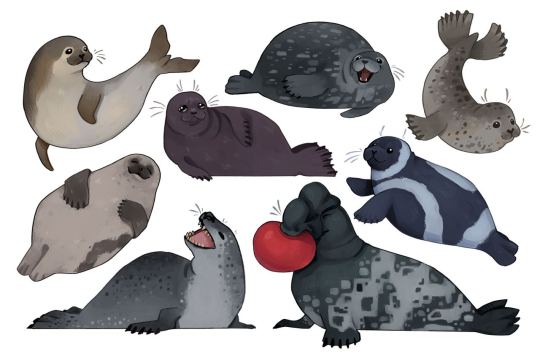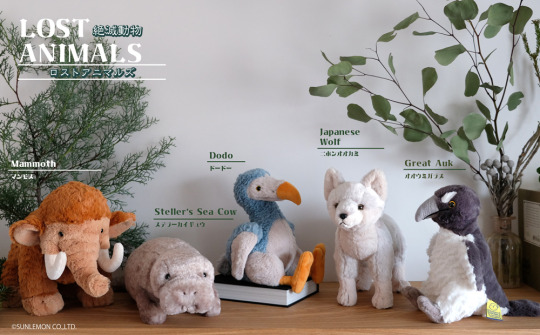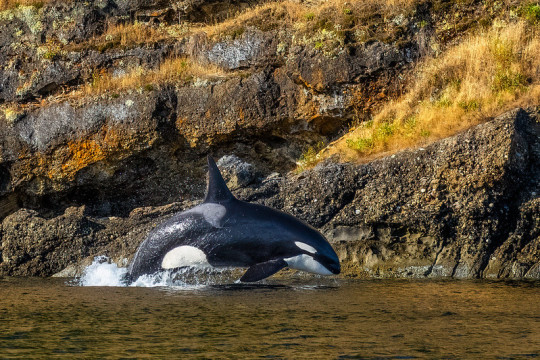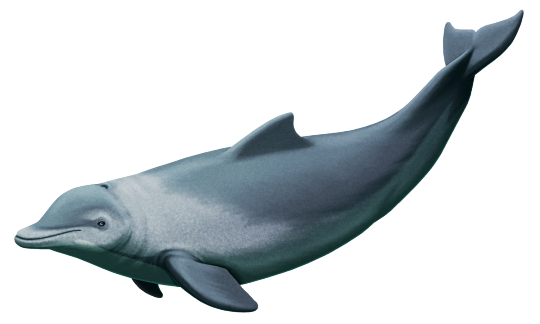#Marine Mammals
Explore tagged Tumblr posts
Text

Hawaiian monk seals (Neomonachus schauinslandi) play in the shallows in Papahānaumokuākea Marine National Monument, Hawai'i
by NOAA Office of National Marine Sanctuaries
#hawaiian monk seal#seals#pinnipeds#marine mammals#neomonachus schauinslandi#neomonachus#phocidae#pinnipedia#carnivora#mammalia#chordata#wildlife: hawaii#wildlife: north america
2K notes
·
View notes
Text
Learning anything about marine mammal training will make you re-evaluate so much of your relationship with your own pets. There is so much force involved in the way we handle domestic animals. Most of it isn’t even intentional, it just stems from impatience. I’m guilty of it myself!
But with the exception of certain veterinary settings where the animal’s health is the immediate priority, why is it so important to us that animals do exactly what we want exactly when we want it? Why do we have to invent all these tools and contraptions to force them to behave?
When a whale swam away from a session, that was that. The trainer just waited for them to decide to come back. If they flat out refused to participate in behaviors, they still got their allotment of fish. Nothing bad happened. Not even when 20-30 people were assembled for a procedure, and the whale chose not to enter the medical pool. No big deal. Their choice and comfort were prioritized over human convenience.
It’s almost shocking to return to domestic animal medicine afterwards and watch owners use shock collars and chokers and whips to control their animals. It’s no wonder that positive reinforcement was pioneered by marine mammal trainers. When you literally can’t force an animal to do what you want, it changes your entire perspective.
I want to see that mindset extended to our domestic animals.
#‘oh I can walk my dog off-leash down a crowded street’ why does that matter?????#the horse world is ESPECIALLY bad about this too#edit: the whips is referring to horses I have not seen anyone whip their dog#pets#horses#animal training#dog training#dolphin training#dolphins#belugas#orcas#killer whales#cetaceans#marine mammals#zoos#aquariums#cooperative care#vet med#vetblr
6K notes
·
View notes
Text

Whale Effigy 🐳 Chumash (California, West Coast), c.1200-1600 Steatite, shell inlay, 7.1 x 9.5 cm Montreal Museum of Fine Arts 1950.51.Ab.9
#animals in art#Chumash art#Native American art#Indigenous art#soapstone#steatite#carving#figure#sculpture#animal effigy#Montreal Museum of Fine Arts#whale#marine mammals#cetaceans#ocean life
1K notes
·
View notes
Text




sold
#mug#coffee mug#otters#otter art#sea otters#marine mammals#marine life#the horrors persist#pottery#ceramic#sgraffito#carving#love
2K notes
·
View notes
Text

it looks like mochimochi is making a heart with her flippers 🥰🩷
881 notes
·
View notes
Text

[ID: A digital drawing of a gray spotted seal facing to the left with its tongue out. The background is a wavy teal with small black fish. End.]
#00219
HARBOR SEAL
Phoca vitulina
CLASS MAMMALIA
CLADE PINNIPEDIA
Harbor seal spot patterns are unique, and can appear either dark-on-light or light-on-dark. Seal pups are able to swim and dive just hours after birth. Adults can grow up to 370lbs.
474 notes
·
View notes
Text

This month's exclusive stickers for my sticker club... Have I told you guys that I really like seals?
#seal#seals#harbor seal#weddell seal#baikal seal#caspian seal#harp seal#ribbon seal#leopard seal#hooded seal#marine mammals#marine biology#art#illustration#cute stickers#sticker#animal art
1K notes
·
View notes
Text

Sunlemon - LOST ANIMALS
#plush#plushie#plushies#plushblr#plushcore#toycore#soft toy#stuffed animals#sunlemon#lost animals#extinct animals#mammoth#steller's sea cow#dodo#japanese wolf#great auk#plush: prehistoric#plush: pachyderm#marine mammals#plush: bird#plush: wolf#plush: canine
2K notes
·
View notes
Text


silly hiyori ! ~
[creds to aguhiyori]
#seal#seals#seal posting#sealblr#i love seals#pinniped#pinnipeds#marine life#marine biology#marine mammals#silly seal#hiyori#blehh :p#tokkari center
370 notes
·
View notes
Text
The popularity of space whale art can be traced to the 1960s and 1970s. A few different cultural currents from that period coalesced into the ‘space whale’ motif. In brief, they are environmentalism, public awareness of scientific advances in understanding cetacean intelligence and behaviour, psychedelic drug culture, and space exploration.
498 notes
·
View notes
Text
🐋Daily Cetacean Fact:🐋
Pygmy Sperm Whale: the whales only come to the water’s surface when the sea and weather conditions are very calm. As a result, scientists rarely see pygmy sperm whales at sea. This makes it difficult to estimate their minimum population size or current population trends. They grow to be only 12ft long and can weigh between 700 and 1,000lbs.


#pygmy sperm whale#pygmy#sperm whale#whale#whale post#whale fact#facts about whales#daily whale#daily whale fact#cetacean#cetacean facts#cetacean post#facts about cetaceans#daily cetacean#daily cetacean fact#respect the locals#marine mammals#marine animals#marine biology#marine life#marine#marine life blog#advocacy for marine life#marine life advocate#ocean animal#ocean life blog#ocean life#ocean
877 notes
·
View notes
Text

An orca (Orcinus orca) breaches off the coast of the Pacific Northwest, USA
by Guy Schmickle
#orca#killer whale#dolphins#cetaceans#marine mammals#orcinus orca#orcinus#delphinidae#cetacea#artiodactyla#mammalia#chordata#wildlife: usa#wildlife: north america
2K notes
·
View notes
Text

Albireonids were an early branch of the delphinoid whales, with their closest living relatives being modern oceanic dolphins, narwhals and belugas, and porpoises. Known from temperate latitudes of the North Pacific Ocean between the late Miocene and the late Pliocene, about 9-2.5 million years ago, their fossil remains are very rare in coastal deposits and they seem to have primarily been offshore open ocean animals.
Albireo whistleri is the best known member of this family, represented by a near-complete skeleton from what is now Isla de Cedros in Baja California, Mexico, dating to the late Miocene between about 8 and 6 million years ago. It was a rather small dolphin, around 2.5m long (~8'2"), with a stocky body, fairly broad flippers, and skull anatomy with some convergent similarities with the modern Dall's porpoise.
Interestingly these dolphins also seem to have frequently had pathological neck vertebrae, with both Albireo whisteri and the younger species Albireo savagei from California, USA, showing unusually asymmetrical atlas bones – but on opposite sides to each other. This might be due to illness or injury earlier in life, or possibly be evidence of some sort of "handedness" with individuals preferring to perform some actions more with one side of their body than the other.
———
NixIllustration.com | Tumblr | Patreon
References:
"Albireonidae." Paleobiology Database, https://paleobiodb.org/classic/checkTaxonInfo?taxon_no=42961
Barnes, Lawrence G. Fossil odontocetes (Mammalia: Cetacea) from the Almejas Formation, Isla Cedros, Mexico. University of California, Museum of Paleontology, 1984. https://books.google.com/books?id=rxyydMGWGqgC
Barnes, Lawrence G. "Miocene and Pliocene Albireonidae (Cetacea, Odontoceti), rare and unusual fossil dolphins from the eastern North Pacific Ocean." Natural History Museum of Los Angeles County Science Series 41 (2008): 99-152. https://www.researchgate.net/profile/Xiaoming-Wang-43/publication/252086599_Geology_and_Vertebrate_Paleontology_of_Western_and_Southern_North_America/links/5625900908ae4d9e5c4bb863/Geology-and-Vertebrate-Paleontology-of-Western-and-Southern-North-America.pdf#page=105
Gillet, Amandine, Bruno Frédérich, and Eric Parmentier. "Divergent evolutionary morphology of the axial skeleton as a potential key innovation in modern cetaceans." Proceedings of the Royal Society B 286.1916 (2019): 20191771. https://doi.org/10.1098/rspb.2019.1771
Thomas, Howell W., et al. "Examples of paleopathologies in some fossil Cetacea from the North Pacific realm." Natural History Museum of Los Angeles County Science Series 41 (2008): 153-179. https://www.researchgate.net/profile/Xiaoming-Wang-43/publication/252086599_Geology_and_Vertebrate_Paleontology_of_Western_and_Southern_North_America/links/5625900908ae4d9e5c4bb863/Geology-and-Vertebrate-Paleontology-of-Western-and-Southern-North-America.pdf#page=159
#science illustration#paleontology#paleoart#palaeoblr#albireo#albireonidae#delphinoidea#dolphin#odontoceti#cetacean#whale#artiodactyla#ungulate#mammal#marine mammals#art#paleopathology
269 notes
·
View notes
Text

Levi Qumaluk (Inuit; Nunavik, 1919-1997) Untitled (Walrus), 1952 Steatite, ivory, 9.4 x 18.7 x 19.7 cm Montreal Museum of Fine Arts 1953.Aa.1
#animals in art#20th century art#Indigenous art#First Nations art#Canadian art#Montreal Museum of Fine Arts#1950s#soapstone#steatite#carving#figure#animal effigy#sculpture#walrus#Arctic animals#marine mammals#Levi Qumaluk#Inuit art
385 notes
·
View notes
Text


Custom Whale Night Light by Ianare
#Ianare#night light#lamp#lamps#custom#lighting#desk decor#gift idea#night lights#lighting decor#whale#ocean#marine life#marine#marine mammals
255 notes
·
View notes